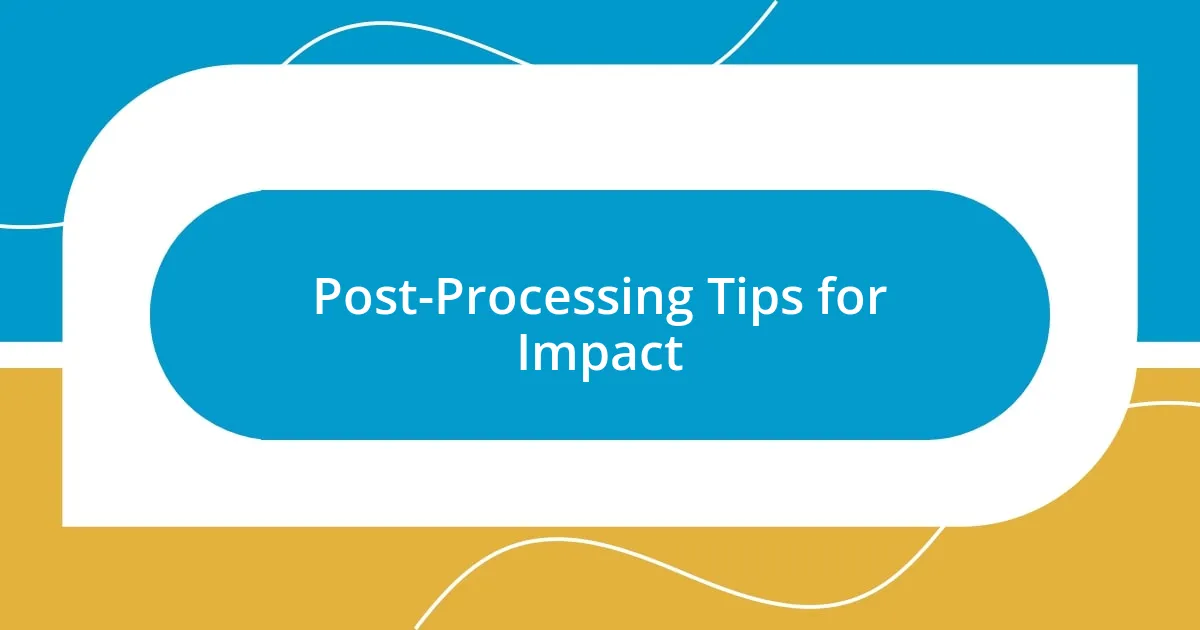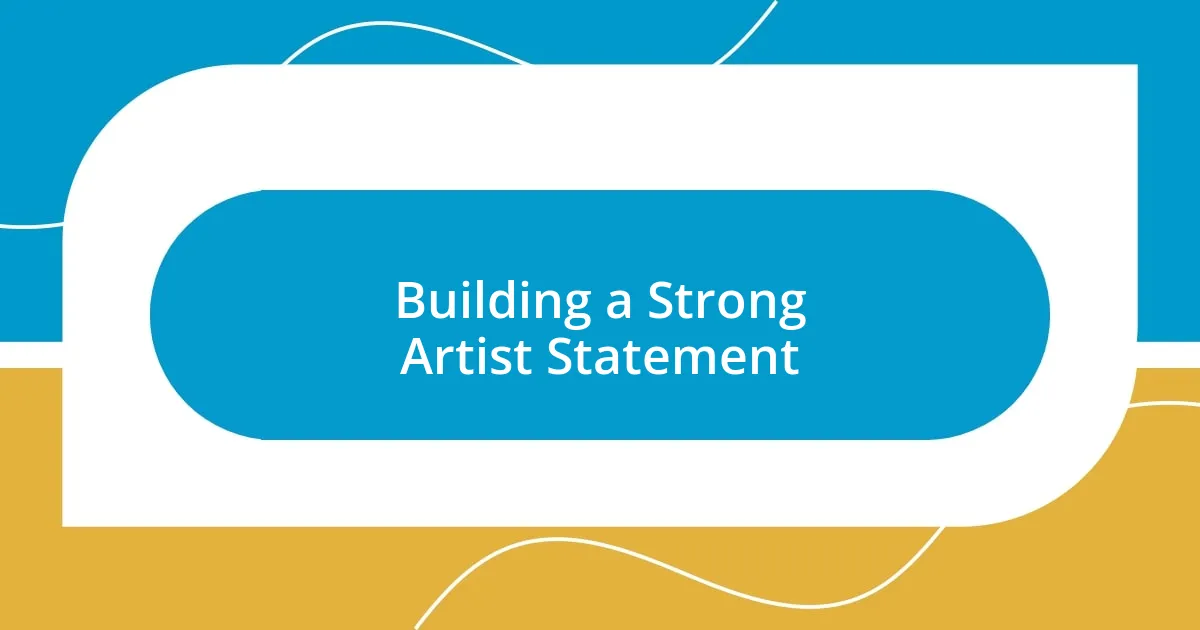Key takeaways:
- Conceptual photography focuses on conveying ideas and emotions, encouraging deeper viewer engagement through storytelling.
- Essential equipment includes a DSLR or mirrorless camera, quality lenses, and lighting gear to help realize creative concepts effectively.
- Techniques such as mind mapping, journaling, and collaboration can enhance idea development and inspire new creative directions.
- Post-processing is crucial for amplifying the emotional impact of images, with techniques like selective focus and color grading enhancing narrative depth.

Understanding Conceptual Photography
Conceptual photography is fundamentally about conveying ideas or emotions rather than merely capturing reality. I remember my first attempt at creating a conceptual piece—I wanted to express the feeling of isolation in a crowded city. I set up a shot of a single figure surrounded by blurred, passing crowds, and it sparked a deeper understanding of how powerful imagery can communicate complex human experiences.
When delving into this genre, I find it’s crucial to think about the story you want to tell. For instance, have you ever considered how one image can evoke nostalgia? That’s what drove me to experiment with vintage props and settings in a recent project. Each element in the frame contributes to a narrative, prompting viewers to reflect on their own memories and feelings.
The beauty of conceptual photography lies in its openness to interpretation. What does a broken mirror symbolize to you? I’ve discovered that each viewer might have a different response, which makes the experience incredibly enriching. Engaging with the audience on an emotional level transforms a simple photo into a conversation, a dialogue that continues long after the shutter clicks.

Essential Equipment for Conceptual Photography
When it comes to conceptual photography, having the right equipment can significantly enhance your storytelling. I’ve learned that while fancy gear can be tempting, it’s the understanding of how to use what you have that makes all the difference. I often find myself reaching for my DSLR or mirrorless camera, but I also make space in my bag for simple tools that elevate my work, such as a reliable tripod and quality lenses.
Here’s a quick list of essential equipment I recommend for conceptual photography:
- Camera (DSLR or mirrorless): The versatility of digital cameras allows you to experiment with different settings and effects.
- Lenses: A prime lens for sharp images and a zoom lens for flexibility can help in capturing varied perspectives.
- Tripod: Crucial for stability, especially in low-light situations or when composing intricate setups.
- Lighting gear: Softboxes or reflectors can dramatically affect the mood of your photos.
- Props: Unique elements that contribute to your narrative—think vintage furniture or intriguing textures.
- Editing software: Programs like Adobe Photoshop or Lightroom for enhancing your final images and playing with creative edits.
With just these essentials, I’ve crafted narratives that resonate deeply with my audience. The right equipment can open doors to infinite creative possibilities, so invest in what allows you to tell your story effectively!

Techniques for Developing Ideas
When brainstorming for conceptual photography, I often turn to mind mapping as a technique. It allows me to visually organize thoughts and capture fleeting ideas. For example, during a recent project, I started with the theme of “identity” and branched out with keywords related to masks, mirrors, and reflections. This method not only helped clarify my vision but also revealed unexpected connections that enriched my final piece.
Keeping a journal is another technique I cherish. Writing down my thoughts, emotions, and experiences helps me articulate the concepts I want to explore through my photography. I recall a time when I stumbled upon a phrase that resonated with me: “the weight of memory.” This phrase inspired a series of photos aimed at depicting nostalgia and the burdens it carries. Through journaling, I translated that concept into emotional imagery, making it tangible for others to connect with.
Lastly, collaboration can ignite inspiration in ways I hadn’t imagined. Recently, I partnered with a painter to merge visual art and photography. The discussions we had fueled my creativity and led to stunning imagery that brought both our visions to life. By sharing ideas and techniques, we pushed each other’s boundaries, proving that sometimes the best ideas are born from the interplay of different artistic minds.
| Technique | Description |
|---|---|
| Mind Mapping | A visual approach to organize ideas and concepts, revealing connections that enhance storytelling. |
| Journaling | Writing down thoughts and emotions helps clarify concepts and translate them into images. |
| Collaboration | Partnering with other artists can inspire fresh ideas and push creative boundaries. |

Importance of Composition Techniques
When I first started exploring composition techniques, I quickly realized how essential they are to creating impactful images. It’s not just about framing a shot; it’s about guiding the viewer’s eye and evoking emotion. I recall a specific moment when adjusting the Rule of Thirds transformed a mundane landscape into something truly striking. I moved my subject off-center, and almost instantly, the image gained depth and intrigue.
One aspect of composition that resonates deeply with me is the use of leading lines. I often look for natural or architectural lines that draw the viewer into the scene. For instance, during a recent shoot in an old train station, the tracks became a pathway for visual exploration. It’s fascinating to see how composition can turn a simple setup into an emotional journey, inviting viewers to wander through the image with anticipation.
I’ve found that understanding techniques like framing and symmetry can enhance storytelling in my work. The last time I shot a portrait, I intentionally framed my subject with elements in the background that spoke to their personality. The result was more than just a face in focus; it told a story of who they are and their surroundings. Have you ever considered how a well-composed photograph can resonate more deeply with an audience? When I marvel at the reactions I receive, it’s clear that thoughtful composition can make all the difference in conveying a powerful narrative.

Utilizing Lighting and Color
Lighting and color are the lifeblood of any conceptual photograph. I remember one shoot where I experimented with golden hour light—those dreamy, warm tones completely transformed the mood of my images. There’s something magical about soft light that can caress a subject, creating an inviting atmosphere. Have you ever noticed how a photo taken in harsher light can seem entirely different? It’s incredible how the quality of light can evoke emotions, guiding the viewer’s response.
Color, too, plays a pivotal role in conveying meaning. I often play with contrasting colors to evoke tension or harmony in my work. For example, during a series about solitude, I used deep blues and stark reds to illustrate the juxtaposition between external chaos and internal calm. The choice of hues didn’t just decorate the image; it layered the emotional narrative, inviting viewers to feel something profound. How do you choose colors for your work? I find it fascinating how certain combinations can spark an immediate emotional reaction.
I often rely on shadows to add depth and intrigue to my photographs. In a project that focused on the theme of duality, I positioned a subject partially in shadow, allowing mystery to seep into the image. I was amazed at how the interplay of light and dark not only accentuated the forms but also told a story that was more complex than I initially intended. It’s moments like these that remind me: the dance of light and color isn’t just technical—it’s a conversation with the viewer.

Post-Processing Tips for Impact
Post-processing is where a photograph really comes to life, allowing me to amplify the impact of my conceptual ideas. I distinctly remember a time when I adjusted contrast and brightness in post-processing to turn an otherwise flat image into a vivid explosion of emotion. Suddenly, the subject’s intensity shone through, making the viewer gasp just a little. Have you ever felt a photograph resonate with you more deeply after a subtle tweak? It’s in these moments that I realize how post-processing decisions can transform an image from good to unforgettable.
One of my go-to techniques is selectively blurring parts of an image to emphasize what matters most. I recall using this technique in a conceptual piece that focused on isolation. By intentionally softening the background and keeping the subject crisp, I was able to draw the viewer’s attention directly to the emotion captured in their expression. This method doesn’t just create visual clarity—it crafts a narrative, prompting viewers to engage more thoughtfully. Have you explored selective focus in your work? When I see the impact it has, it feels like I’m inviting a deeper connection with the audience.
I also enjoy experimenting with color grading during the post-processing phase. There was a time when a blue-tinged palette seemed perfect for a project on nostalgia. The hues wrapped around the image like a warm blanket, instantly evoking feelings of longing. By adjusting vibrancy and saturation, I found the perfect balance, and the final result resonated with viewers, sparking conversations about their pasts. Isn’t it interesting how color can unlock emotions hidden deep within us? This is why I believe that post-processing is not just technical—it’s an art form in itself that breathes life into the stories we aim to tell.

Building a Strong Artist Statement
Crafting a compelling artist statement is about capturing the essence of your work in a way that resonates. I remember struggling with my first statement, trying to convey my artistic journey while feeling overwhelmed by the pressure to impress. It was only when I shifted my focus to authenticity that the words started flowing. Have you ever thought about how honesty can be your strongest tool? When I speak from the heart about my motivations and inspirations, I find that others genuinely connect with my vision.
Being concise is more challenging than it seems when creating an artist statement. I’ve learned that the beauty often lies in the details—highlighting specific projects or techniques that define my style. For instance, when I mentioned a series where I explored the fragility of human emotions, people began to ask questions that fostered meaningful conversations. What elements of your work do you find most impactful? By emphasizing unique aspects, I realized that I invite viewers into an engaging dialogue rather than simply sharing facts.
Lastly, revisiting my statement periodically has proven to be essential. As my work evolves, so should the narrative around it. I find it exhilarating to reflect on how my perspective has changed alongside my photography. The journey feels alive when I infuse fresh insights or experiences into my statement. Have you ever updated your artist statement? Each revision feels like a chance to cultivate a deeper understanding of both my art and myself.














